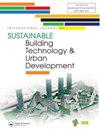Using streamlined MIPS to evaluate environmental performance: a case study of the University of Nottingham Ningbo China campus
Q4 Engineering
International Journal of Sustainable Building Technology and Urban Development
Pub Date : 2016-10-01
DOI:10.1080/2093761X.2017.1302836
引用次数: 0
Abstract
AbstractThis article reports on a Chinese application of the material input per service (MIPS) concept used to characterise and quantify the relationships between MIPS provided by a university campus. The case study area chosen is the University of Nottingham Ningbo China (UNNC) campus. Materials flow accounting is applied to quantify the stock and flow of key construction materials inputs within the campus from 2008 to 2015. The number of degrees conferred (unit of service provided by a university campus) in a year is then factored to the materials input of that particular year. It is concluded that MIPS – which links a service (in this case, university education) enabled by a given product (campus facilities) to the amount of materials, energy, and emissions used or produced in creating that product – offers an interesting way to evaluate the environmental performance of a product if the service unit is properly defined.利用简化的MIPS评估环境绩效:以诺丁汉大学宁波校区为例
摘要本文报道了在中国应用每项服务的物质投入(MIPS)概念来描述和量化大学校园提供的每项服务之间的关系。选择的案例研究区域是宁波诺丁汉大学(UNNC)校园。材料流会计应用于量化2008年至2015年校园内关键建筑材料投入的库存和流量。一年中授予的学位(大学校园提供的服务单位)的数量被计入该特定年份的材料投入。结论是,MIPS——将特定产品(校园设施)所提供的服务(在本例中是大学教育)与创造该产品所使用或产生的材料、能源和排放量联系起来——提供了一种有趣的方式来评估产品的环境绩效,如果服务单元得到适当定义的话。
本文章由计算机程序翻译,如有差异,请以英文原文为准。
求助全文
约1分钟内获得全文
求助全文
来源期刊

International Journal of Sustainable Building Technology and Urban Development
Engineering-Building and Construction
CiteScore
1.20
自引率
0.00%
发文量
0
期刊介绍:
The International Journal of Sustainable Building Technology and Urban Development is the official publication of the Sustainable Building Research Center and serves as a resource to professionals and academics within the architecture and sustainability community. The International Journal of Sustainable Building Technology and Urban Development aims to support its academic community by disseminating studies on sustainable building technology, focusing on issues related to sustainable approaches in the construction industry to reduce waste and mass consumption, integration of advanced architectural technologies and environmentalism, sustainable building maintenance, life cycle cost (LCC), social issues, education and public policies relating to urban development and architecture .
 求助内容:
求助内容: 应助结果提醒方式:
应助结果提醒方式:


